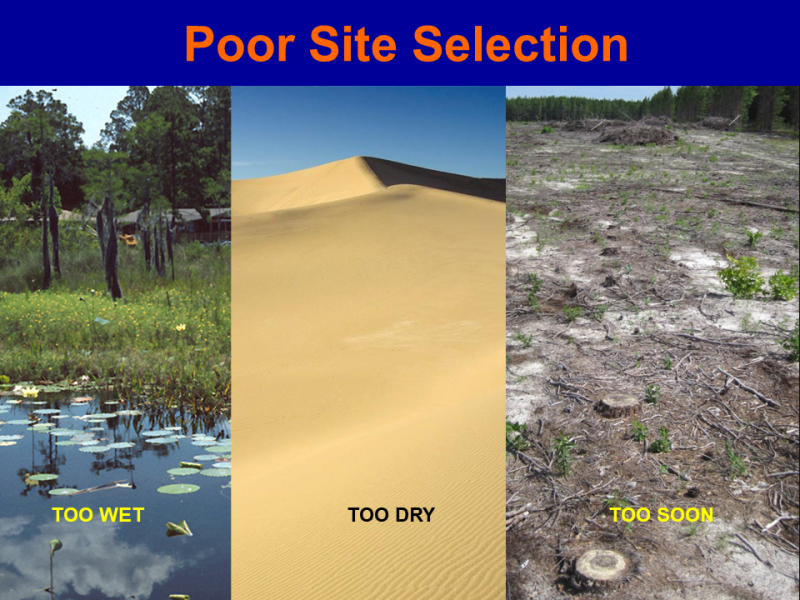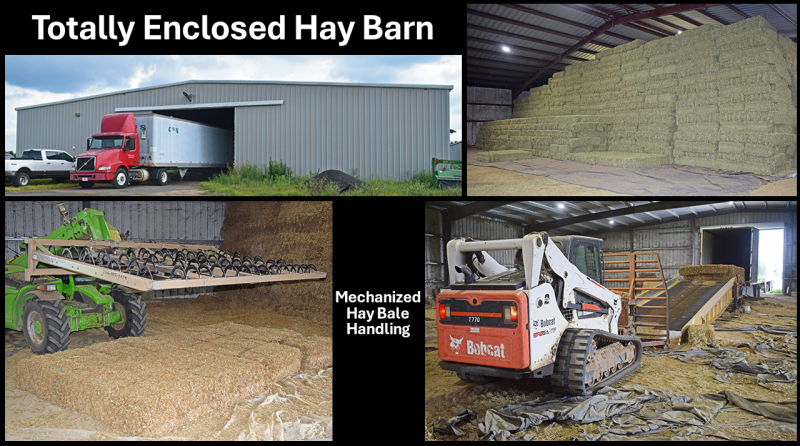Profitable commodity crop or livestock production has become more challenging since the COVID19 Pandemic. Production costs have increased more significantly than market prices for most of the commodity options produced in the Panhandle. The following chart from USDA’s National Agricultural Statistic Service (NASS) shows a comparison of indexes for market prices received by crop farmers (red) in comparison with an index of production expenses paid by the farmers. This chart below does not show profit or loss, but simply the percentage change in comparison to the base year of 2011. Prices paid for input costs have increased 40% since 2011, with a slight decline from the peak of 2023. Prices received or farm gate sales peaked in 2023 at nearly 30% above 2011, but have since fallen back to near 2011 levels in 2024. Margins on most commodity crops have gotten really tight, so barring some significant changes to the Farm Bill Crop Programs, this will continue to be an issue.
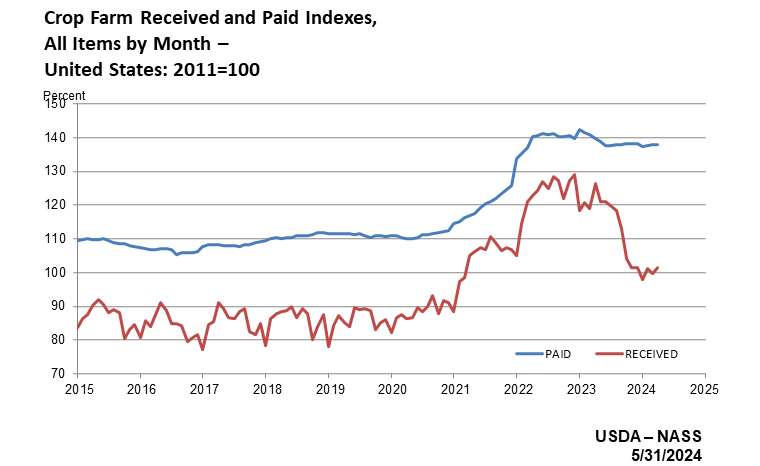
Source: USDA Charts and Maps
Definition: Prices received represent sales from producers to first buyers. They include all grades and qualities.
Definition: Prices paid by farmers represent the average costs of inputs purchased by farmers and ranchers to produce agricultural commodities.
USDA’s Agricultural Prices Report, released May 31, 2024, by the National Agricultural Statistics Service (NASS)
–
Perennial Peanut Hay Production
At the recent Perennial Peanut Field Day, held in Quincy on June 6, I was reminded by several veteran hay farmers that Perennial Peanut, also called Rhizoma Peanut, is a crop many farmers in North Florida should consider including in their diversified farming operations. Like any type of farming there are some major challenges to starting a new type of operation, and specifically for producing high quality square-bale hay, but it is one of the very few crop options that provides consistent income year after year. Hay is generally sold either directly farmer to farmer, or perhaps with only with one broker or middle marketer in between, so the price is more consistent than commodity markets that are influenced by world supply and demand, and futures market speculation.
There are some real opportunities selling perennial peanut square-baled hay. If you are not that familiar with this crop, you may want to read through the UF/IFAS Extension Fact Sheet: Rhizoma Perennial Peanut. Perennial peanut Arachis glabrata is not native to this area, but was brought to the U.S. from Brazil and Argentina in the 1930s from the same regions where bahiagrass can be found, so it is a tropically adapted crop. Perennial Peanut is a legume, so like it’s cousin the traditional peanut Arachis hypogaea, it does not require nitrogen (N) fertilization beyond establishment. As the name implies, this forage crop is not an annual that must be planted each season, so once it is established, it can persist for many years (25+). Because it is a broad-leafed-legume, this crop is also highly nutritious for livestock, similar to alfalfa, soybeans, and traditional peanut vines. Like bahiagrass, perennial peanut also does not have major insect or fungal disease issues. In general, perennial peanut is a relatively low maintenance, environmentally friendly forage, that can add diversity to crop and livestock operations in the Gulf Coastal region where the ground does not freeze in winter.
Of course, the main advantage to this crop is that “clean and green” perennial peanut square-baled hay commands a premium price similar to alfalfa for livestock or deer feeding. The vast majority of this premium hay is being sold to horse farms in the region. According to the 2022 Census of Agriculture, there were 7,304 horses and ponies in the 16 counties in the Florida Panhandle, as compared to 83,114 horses statewide. This means that only 9% of the market is in the local area. I realize that many horse farms in the state were not enrolled in USDA FSA programs in 2022, so the Census of Ag data may not capture the total market, but it does show the discrepancy and highlight that the primary market is not local and is in Central and South Florida.
–
Yield and Profit Potential
Perennial peanut farmers can produce square-baled hay that commands a premium price in the hay market. So, what is the expected yield and market price? Like most agricultural production, yield varies somewhat from farm to farm depending on soil type and overall management. Authors of the UF/IFAS Perennial Peanut Fact Sheet said, “Perennial Peanut can be used for hay production, silage, or grazing, with dry-matter yields ranging between 3–6 ton/acre.” The average production reported by veteran perennial peanut hay producers is 140 square bales/acre from 2-3 cuttings per year. It is possible to get higher yields on premium crop acreage with irrigation at around the 200 bale per acre range, but for planning sake I would not base a budget on top yields. The current market price for perennial peanut hay delivered to the Ocala and Central Florida area is $13 per 50# bale for premium #1 hay. The variable rate cost of production per acre is around $600/acre, so the return over variable costs is around $1,200 per acre. The truth is that not all of your production will be #1 premium hay, there will be 20-25% that either gets rained on, or will be discounted from weed pockets in a field. This imperfect or #2 hay is typically sold at a $2-3/bale discount and fed to goats, sheep, or round baled for cattle with a greater discount. Hay sold direct from the farm to the local market sells in the $10-12/bale range depending on quality and volume. So, even if you use a conservative yield of 100 #1 bales/acre at $12/bale and 40 #2 bales/acre at $10/bale you are looking at $1,600 of income per acre, with $1000/acre left to cover overhead costs and profit. This is a significant increase in income/acre, when compared with traditionally grown commodity crops in North Florida in 2024.
By now I am sure you are wondering, “If it is that good, why aren’t more farms doing this?” There have been some pretty large hurdles that innovative farmers and forage researchers had to overcome to make this a profitable operation worth pursuing. #1 Hay farmers have figured out how to use machinery to minimize labor. This was a huge advance just like in other forms of agriculture. However, there is a significant equipment investment that we will discuss in more detail under challenges. #2 The University of Florida has released three new cultivars of perennial peanut (Tito, Peace, & Ecoturf) that have significantly higher and more constant yields than the original Floriagraze cultivar that was released in 1979. The old Floriagraze has persisted well since introduction, but has had declining yields in recent years, because it is susceptible to the peanut stunt virus that has moved across the region and has affected most of the previously planted fields. #3 The product has been accepted well by the Florida Equine Industry. Early on hay farmers had to sell perennial peanut at a significant discount to alfalfa to get horse owners to try it. Today, the demand for perennial peanut hay exceeds the supply available every year, so there is definitely room for expansion.
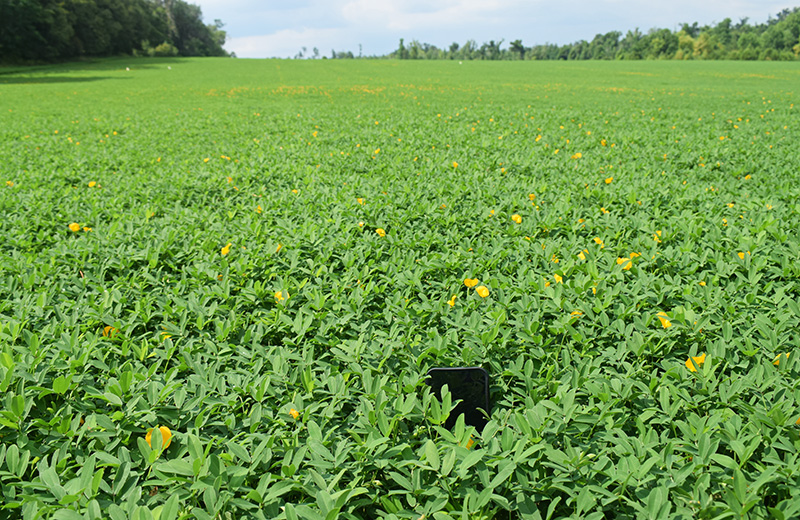
Tito Perennial Peanut three weeks after first cutting on June 26, 2024 at Basford Farms, Grand Ridge. The black object near the front and center of the photo was my iPhone 14 that is 6″ tall. In general, 12″ tall perennial peanut hay is ready to harvest, if the the weather is right. The Tito cultivar is peanut stunt virus resistant and is much faster growing than the older Florigraze variety. Currently this field is nearly weed free, dense and fully established, and growing well without irrigation, which is ideal for premium hay production. Credit: Doug Mayo, UF/IFAS
–
Challenges to Starting a Perennial Hay Operation
Now that I have your attention, I am sure you are aware every crop and operation management system has its challenges, and perennial peanut is no different. There are some significant challenges to overcome to start a premium hay operation.
–
Site Selection
If you are going to invest in perennial peanut, you have to select a site that will allow it thrive, not just survive. Perennial peanut does not survive in low, frequently wet areas. While it can be grown in sandy, well drained soils, it will be more productive in soils with better water and nutrient holding capacity, much like traditional row crops. Don’t plant this on your worst field, far from your headquarters, but instead utilize one of your best fields close to home, so you can pay close attention to weed outbreaks or other issues that may arise. Once it is well established, this is a beautiful crop all summer long, so don’t hide it away on the back of the farm. You also don’t want to plant into a field that is not ready for crop production. The photo above to the right is an example of a field that is several years away from any type of crop production. If you are transitioning from crop land to perennial peanut, I would encourage you to visit with your local NRCS staff, because this would be a good project to submit for EQUIP cost-share funding. Like planting other high-value crops, the key goal is to have a smooth, weed free area ready to plant and prepared well in advance of the anticipated planting date. Depending on the site you choose, this may require some advanced preparation, especially if the field has been used previously for grass production, or has some significant weed challenges such as common Bermudagrass, blackberry briars, or other hard to control perennial species.
–
Establishment
Over the years there have been some significant developments in cultivars and herbicide options for weed control that have improved the establishment process, but it still takes at least two years for this crop to fully establish. This plant grows a root system and then sends up stems with leaves, so unlike Bermudgrass, there are not large runners that quickly cover the ground. Even though we call this a peanut, it does not produce seeds that can be used for planting. Perennial peanut is planted from vegetative material, specifically the underground rhizomes, not from seed. This is not an operation most farms can do for themselves, so you will have to hire a professional to plant this crop. The recommended planting rate is 80 bushels per acre, which are currently sold at a cost of around $10/bushel. There is a 20 to 1 ratio for dug nursery to planting (1-acre dug to plant ~20 acres worth of rhizomes), so once you have established fields, you can save on the cost of sprigs for expansion into future fields. Depending on the distance traveled by the sprigger you hire, you can expect a fee in the neighborhood $200/acre for the machines used for planting. This is an expensive crop to plant at $1,000/acre. If you are going to be in the premium hay business shipping and selling truckloads of hay to the prime market, you really need at least 100 acres to get started. However, if you do a good job with site selection and a clean seedbed, you should be able to harvest your first hay in the fall of the second year, so starting the 3rd and 4th year, your income should grow enough to more than cover variable costs, and start paying down the debt of establishment. The main point here is that you will need to work with your accountant and your lender for a long-term payback and depreciation plan.
There are two annual planting windows for establishment. The primary planting window for this crop has been mid-January through March, when the plants are still dormant. However, spriggers have also had good success plating in mid-May and June, after the carbohydrate levels in the field to be dug for rhizomes returns to normal following spring green up. There are several perennial peanut farms in North Florida that can provide both planting materials of the new cultivars and also have the equipment for planting.
–
Equipment Costs
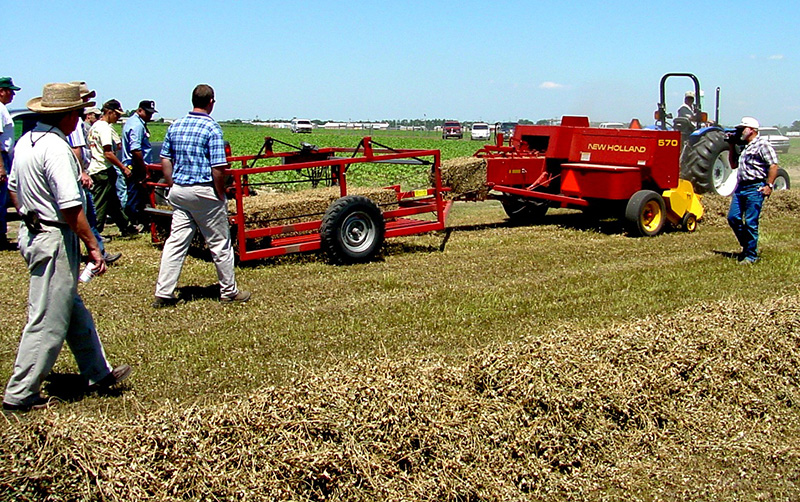
Like most every type of modern farming operation, specialized equipment such as this 10 square-bale hay accumulator being demonstrated at the Sunbelt Ag Expo is a key part of the mechanization of premium hay production. Credit: Doug Mayo, UF/IFAS
Just like any other operation in modern agriculture, taking on a new venture requires significant investment beyond planting costs. Premium hay production requires very specialized machines for this type of operation. Mechanization is key, as you want to minimize manual labor (I did not say eliminate) with hay as much as possible. You can start with used equipment, but beware of anything that has previously been seriously damaged or warped. For simplicity sake here I going to offer some suggestions for equipment needed for a premium hay operation. Depending on the equipment already available on the farm, equipment purchase could be another $150-300 K investment .
- 85-100 horse tractor equipped with a loader (120-150 horse tractor offers more height for stacking hay on trailer and barn, and more power for larger mowers)
– - 50-80 horse tractor to pull tedder and rake while larger tractor is bailing, and for pulling large flatbed trailers for field loading.
– - Quality hay mower/conditioner to reduce drying time $30-$70 K (wider is better, but mowing is the fastest and easiest part)
– - Tedder to aid in even drying $20-40 K (be careful with hay nearly dry as their will be leaf loss from tedding)
– - Adjustable PTO driven Rotary or Twin Rake $40 K (ground driven wheel rakes, popular for round bales, pick up dirt and debris and are not recommended for premium square-baled hay harvesting)
– - Square baler $40 K (don’t skimp here as this machine is vital for timely and consistent harvest)
– - 10-Bale Accumulator $25 K (pulled behind baler to make loading easier as in photo to right)
– - 10-Bale Hay Grapple $13 K (loader attachment to pick up 10 bales at one time, as seen below)
– - Flatbed Trailer (used for transporting hay from field to barn, and possibly for delivery to customers)
– - Three point hitch sprayer (timely weed control is a major management issue)
_ - A Loading ramp for semi-trucks, and a bobcat, such as the ones picture below, are also handy to reduce loading time.
–
On-Farm Hay Storage
An enclosed storage barn is a must, if you are selling premium hay. Sunlight bleaches legume hay, and moisture promotes mold growth, so an enclosed barn protects this high-value crop. Solid flooring is also important to ensure stacks are stable. You don’t have to have concrete floors, but 4″ of limerock and 4″ of asphalt milling make a solid and stable floor for hay stacks. It takes 50 square feet of floor space to store 100 bales in 10 x 10 stacks, so you would need a minimum of 7,500 square foot barn for 15,000 square bales of hay (~100 acres). There are machines, such as the Merlo Telescoping Telehandler in the photo above, that can stack hay higher than a loader on a tractor, so you can go higher than 10 bales, if your barn is tall enough as in the picture above. The bottom line is that you need enough space to store a whole seasons-worth of production, so you can have inventory continuously available for customers. It is nice to have enough space for loading in all weather conditions like the photos above, but this also can be handled outside the barn to maximize storage space.
–
Weed Control
Talk to any perennial peanut hay producer and ask their main issues. Chances are pretty high they will bring up weed control as one of their biggest challenges. Their customer has no tolerance for weeds and yet this broad-leaf crop is not as dense as grasses, so weeds are a major pest issue. It is also a minor crop, in the grand scheme of U.S crop production, so the toolbox of herbicides is limited. Glyphosate can be used in the dormant season to control winter weeds, and at low rates on very small annual weeds in season. Impose (imazapic) not Cadre, is labeled for perennial peanut and can be used immediately after planting (within 7-10 days after planting and before plant emergence), early season, and post-harvest as a good preemergence and weak post-emergence herbicide. Clethodim (Select and other generic brands) offers grass control. 2,4-D Amine at no more than a pint per acre can be applied in season with minimal crop damage. Combinations of these chemicals can be used on harder to control annual weeds, but will stunt the crop to some degree and reduce yield. None of these herbicides will control 12-24″ or larger weeds, so timely herbicide spraying is a must. Even if you stay on top of your weed control, hand weeding crews may be required before harvest on escaped weeds for premium hay. Weed control is critical during establishment, as high populations of weeds can delay complete establishment 1-3 years. It doesn’t stop there though, as managing weeds before or soon after emergence is a routine part of perennial peanut hay management.
–
Marketing Your Product
If you are in the premium hay business you have to market your hay and build relationships with clients, not just negotiate a one-time sale. There are no local buying points for square-baled hay, so marketing is something you have to work on throughout the year. Cash flow can also be a challenge as when perennial peanut hay is growing well, so are pastures on your customers’ farms, so the primary market is through the fall, winter, and early spring months. Some horse farms feed hay year round, but typically not at the same quantity as the cool-season months. You want to become a horse farm’s hay supplier, which requires having inventory reserved for your regular customers. Most horse farms don’t have adequate hay storage to buy all of their needs at one time. If you don’t like dealing with people, this may not be the business to get into. The product sells itself, once people try it, but you still have to make the effort to keep the relationships going. If you sell your hay first come first serve, you won’t build relationships. You want to be a farm’s main supplier not just a name on a list of possible vendors. To do that you have to have product when your customer needs it, and make good on any issues that arise. You will also need to market your farm products through a social media or a more static website, so buyers can find you and and your contact information. I would definitely suggest joining the Perennial Peanut Producer’s Association, so you can get help building your network with other growers and potential customers.
–
Final Thoughts
I have given you a lot to think about here and we have not fully discussed the art and science of managing and producing high quality hay. My goal for this article was simply to get you to start considering if perennial peanut might be the right opportunity to further diversify your farm. The end product is in high demand, so there is definitely room for expansion. There is a lot to consider before jumping into something new with a sizeable investment. Visit a local perennial peanut farm to see what they are doing. The Perennial Peanut Producers Association (PPPA) provides a list of current members on their website, so contact the ones near you and schedule a visit. Talk with your local county extension agent to get their thoughts about this industry. Starting any type of operation that is totally new should be something done with careful planning and patience. Start small and build as you learn the ins and outs of a new industry. I primarily wanted you to recognize that there is real opportunity to add perennial peanut to diversify your farm to help stabilize your farm’s annual income. Perennial peanut hay production definitely warrants further investigation.
–
I want to thank Steve Basford, Basford Farms, Grand Ridge,FL and Richard Cone, Cone Family Farms, Greenville, FL for providing input and suggestions for this article. These are two of the true innovators that pioneered the perennial peanut hay industry in Florida.
- Friday Feature:Malone Pecan Festival Tractorcade - November 21, 2025
- October 2025 Weather Summary and Winter Outlook - November 14, 2025
- Friday Feature:The Untold Story Behind the Beef for Dinner Tune - November 14, 2025

